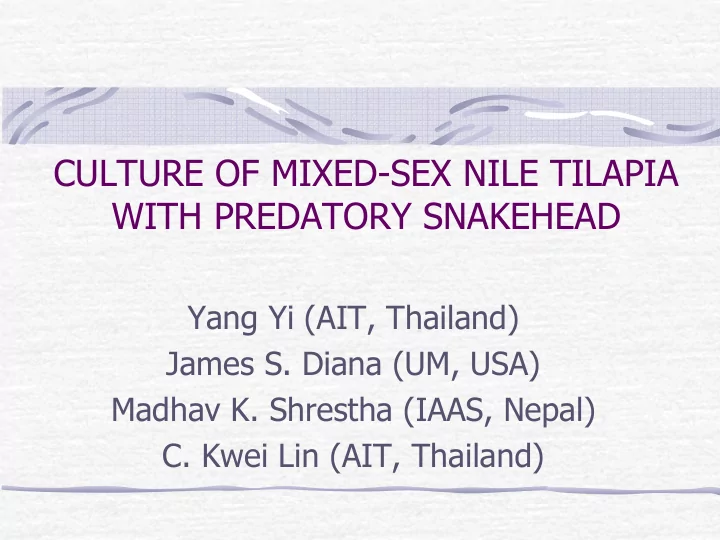

CULTURE OF MIXED-SEX NILE TILAPIA WITH PREDATORY SNAKEHEAD Yang Yi (AIT, Thailand) James S. Diana (UM, USA) Madhav K. Shrestha (IAAS, Nepal) C. Kwei Lin (AIT, Thailand)
ACKNOWLEDGEMENT This Research was funded by Pond/Dynamics Aquaculture CRSP Project
INTRODUCTION Nile tilapia is one of the potential aquaculture species both in intensive and semi-intensive systems. Feeding on lower trophic levels provides its greatest potential for efficiency in semi-intensive system. Easy breeding and free seed availability is an opportunity to small scale resource poor farmers. However, overpopulation and stunted growth in stocked pond has been considered a greatest problem.
INTRODUCTION (Cont’d) Mono-sex culture of Nile tilapia has been popular for population control. Efficient hatchery are needed to produce mono-sex fry which are not available in many developing countries and out of reach to resource poor farmers. Various predatory fish species have been used for the control of recruitments as a biological method with varying success. Snakehead is a valuable food fish and also cultured to some extent and, is highly predaceous and reported to prey effectively on live tilapia fry.
OBJECTIVES To assess the efficiency of snakehead in controlling overpopulation of of mixed-sex Nile tilapia in ponds. To assess the growth and production of Nile tilapia in monoculture and polyculture with snakehead.
MATERIALS AND METHODS Treatments: 6; Replication: 3; Design: RCBD (A) Monoculture of sex-reversed all male tilapia (B) Monoculture of mixed-sex tilapia (C) Polyculture of snakehead and mixed-sex tilapia at 1:80 ratio (D) Polyculture of snakehead and mixed-sex tilapia at 1:40 ratio (E) Polyculture of snakehead and mixed-sex tilapia at 1:20 ratio (F) Polyculture of snakehead and mixed-sex tilapia at 1:10 ratio Culture species: Sex-reversed Nile tilapia ( Oreochromis niloticus ) 10.5-11.6 g Mixed-sex Nile tilapia ( Oreochromis niloticus ) 7.2-8.1 g Snakehead ( Channa striata ) 88.0-100.0 g
MATERIALS AND METHODS (Cont’d) Stocking density • Nile tilapia 2 fish m -2 in all treatments (A to F) • Snakehead 0.025, 0.05, 0.1 and 0.2 fish m- 2 in treatments C, D, E and F, respectively. Experimental conditions: Earthen ponds of 200 m 2 each Fertilized pond system Duration: March to October 2000 (194 days) Experimental site: Asian Institute of Technology, Thailand)
RESULTS Growth performance of Nile tilapia in fertilized earthen ponds in sex-reversed (A) and mixed sex (B) monoculture treatments and, snakehead and mixed-sex tilapia polyculture treatments C to F. Treatment Initial Final Weight gain Survival (g) (g) (g/d) (%) Sex-reversed 9.0 157.7 0.77 83 A. Mixed-sex 7.4 149.8 0.73 83 B. 1:80 7.7 158.0 0.77 81 C. 1:40 7.5 152.9 0.75 78 D. 1:20 7.6 158.2 0.78 81 E. 1:10 7.7 155.3 0.76 82 F.
RESULTS (Cont’d) Mean recruit number and yield and total NFY and GFY of Nile tilapia in treatment A to F. Treatment Recruit Recruit Adult Total Total yield NFY NFY GFY (no) (t/ha/yr) (t/ha/yr) (t/ha/ yr) (t/ha/yr) A. Sex-reversed -- -- 4.54 4.54 a 4.88 a B. Mixed-sex 951 0.88 4.33 5.21 b 5.49 b C. 1:80 -- -- 4.50 4.50 a 4.79 a D. 1:40 -- -- 4.19 4.19 a 4.48 a E. 1:20 -- -- 4.51 4.51 a 4.79 a F. 1:10 -- -- 4.47 4.47 a 4.76 a
RESULTS (Cont’d) Growth performance of snakehead in polyculture with Nile tilapia (Mean). Parameter Treatment Treatment Treatment Treatment C D E F (1:80) (1:40) (1:20) (1:10) Stocked wt. (g) 94.5 93.7 95.8 95.7 Harvest wt. (g) 441.3 a 292.0 b 179.3 c 123.3 d Survival (%) 91 84 95 88 Daily growth (g/d) 1.79 a 1.02 b 0.43 c 0.14 d Net yield (t/ha/yr) 0.14 a 0.14 a 0.13 a 0.05 b Gross yield (t/ha/yr) 0.18 a 0.23 b 0.31 c 0.41 d
RESULTS (Cont’d) Combined yield of Nile tilapia and snakehead in fertilized pond. Treatment Adult tilapia + snakehead Adult and recruit tilapia + Snakehead Net yield Gross yield Net yield Gross yield (t/ha/yr) (t/ha/yr) (t/ha/yr) (t/ha/yr) A. Sex-reversed 4.54 4.88 4.54 4.88 B. Mixed-sex 4.33 4.61 5.21* 5.49 C. 1:80 4.63 4.97 4.63 4.97 D. 1:40 4.39 4.71 4.39 4.71 E. 1:20 4.64 5.11 4.64 5.11 F. 1:10 4.52 5.16 4.52 5.16
RESULTS (Cont’d) Partial budget analysis (US $) based on 200-m 2 pond in 194-day experiment. Parameter Treatment A B C D E F mono mixed 1:80 1:40 1:20 1:10 Gross revenue Adult tilapia 19.46 18.36 19.08 17.87 19.10 18.98 Recruits -- 1.16 -- -- -- -- Snakehead -- -- 1.91 1.82 1.67 1.08 Total 19.46 19.55 20.99 19.69 20.77 20.05 Variable cost Tilapia fingerling 5.00 1.67 1.67 1.67 1.67 1.67 Snakehead fingerling -- -- 0.07 0.14 0.29 0.58 Urea 6.75 6.75 6.75 6.75 6.75 6.75 TSP 6.56 6.56 6.56 6.56 6.56 6.56 Working capital cost 0.78 0.64 0.64 0.64 0.65 0.66 Total cost 19.09 15.62 15.69 15.76 15.92 16.22 Net Return 0.37 3.93 5.30 3.92 4.85 3.83
CONCLUSIONS Snakehead were able to completely control tilapia recruitment at very low snakehead : tilapia ratio of 1:80 indicating high efficiency in recruitment control. Snakehead growth decreased with increasing ratio and carrying capacity of snakehead was exceeded at the ratio of 1:10, and poor growth occurred due to limited food items available. Growth of sex-reversed all male tilapia was only 5% faster than mixed-sex tilapia with no significant difference.
CONCLUSIONS (Cont’d) Final size and yield of harvested adult tilapia were no significant differences among treatments. Partial budget analysis showed that it is better to use mixed-sex tilapia with low ratio snakehead instead of using sex-reversed tilapia in semi-intensive system.
Recommend
More recommend